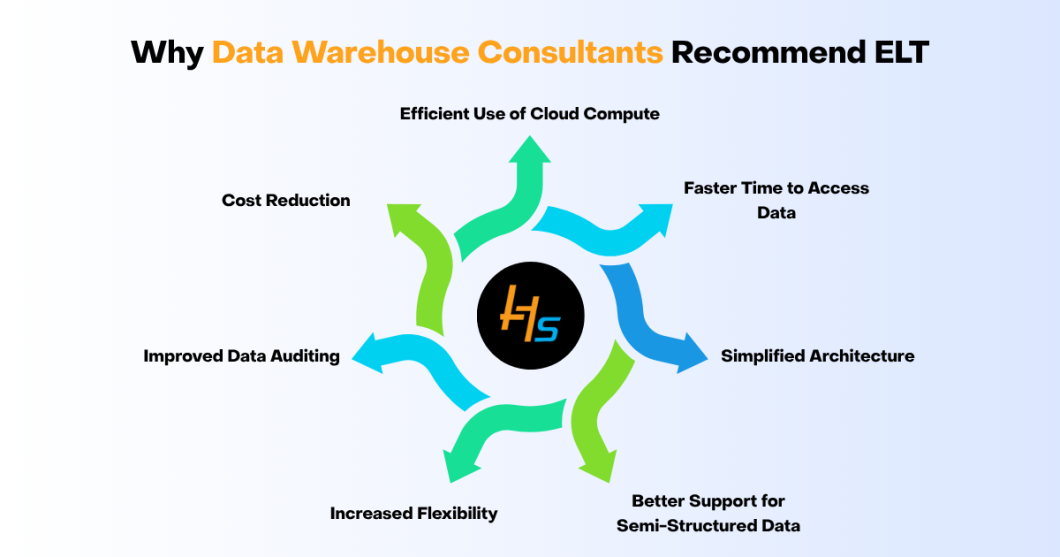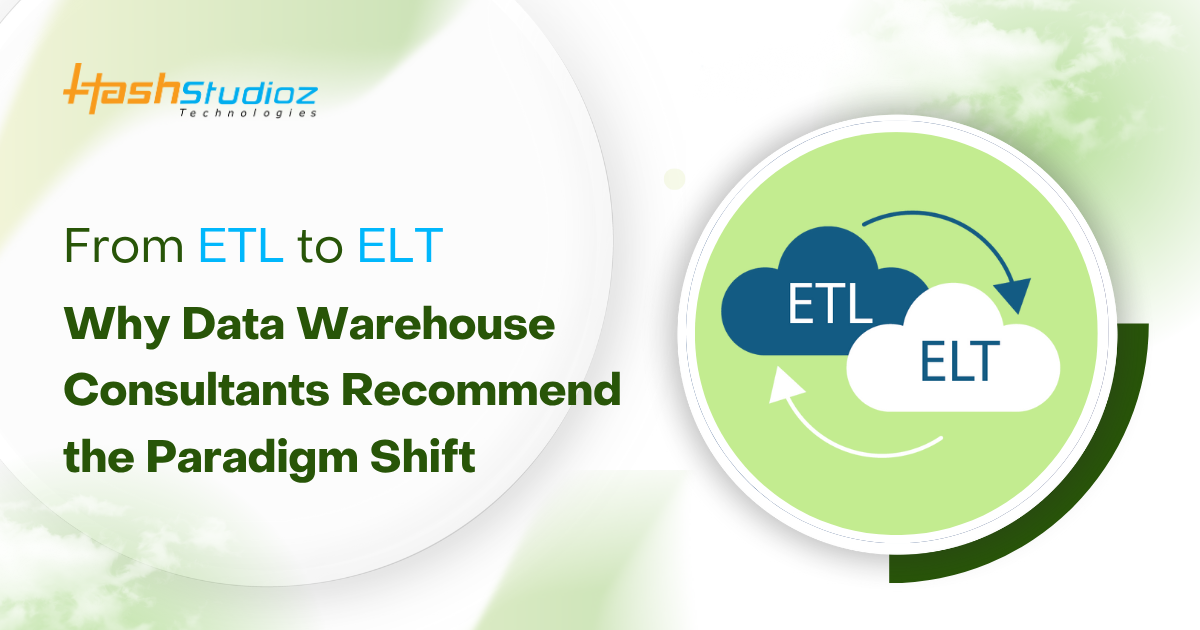For decades, ETL (Extract, Transform, Load) has been the backbone of data integration workflows. But in today’s fast-evolving data landscape, many experts in Data Warehouse Consulting recommend a shift to ELT (Extract, Load, Transform). This transformation is not just a trend—it’s a response to technological changes in data platforms, processing needs, and business demands.
Table of Contents
- Understanding ETL and ELT
- Why Data Warehouse Consultants Recommend ELT
- Technical Criteria for Choosing ELT
- The ELT Technology Stack
- Role of Data Warehouse Consulting Services in ELT Migration
- Challenges and Risks in ELT Adoption
- Consultant Recommendations for Managing ELT Challenges
- Why Choose HashStudioz for Your ELT Transformation?
- Conclusion
Understanding ETL and ELT
1. What is ETL?
ETL stands for Extract, Transform, Load. The process involves:
- Extracting data from multiple source systems.
- Transforming data using external tools before storage.
- Loading cleaned and formatted data into the data warehouse.
Traditionally, this model was designed for on-premise systems with limited storage and compute capabilities.
2. What is ELT?
ELT stands for Extract, Load, Transform. It changes the order of operations:
- Extract raw data from sources.
- Load it directly into the data warehouse.
- Transform the data using the warehouse’s compute power.
In ELT, the transformation logic is executed inside the warehouse after loading, using SQL, stored procedures, or specialized tools.
Why Data Warehouse Consultants Recommend ELT
Consultants working in Data Warehouse Consulting Services are shifting clients toward ELT for a number of reasons. These are some of the most significant technical and operational drivers.
1. Efficient Use of Cloud Compute
Modern cloud data warehouses offer near-unlimited compute resources. ELT takes advantage of this by executing transformations inside the warehouse. This avoids moving data between systems and reduces processing time.

2. Faster Time to Access Data
In ELT, raw data is available immediately after loading. Analysts don’t have to wait for long transformation processes to finish. This improves decision-making and shortens reporting cycles.
3. Simplified Architecture
With ELT, there is no need for a separate transformation engine. The entire data pipeline can be managed within the warehouse, reducing system complexity and maintenance.
4. Better Support for Semi-Structured Data
Modern datasets often include JSON, XML, and log formats. ELT allows this data to be loaded in raw form, then processed using flexible SQL-based logic. ETL tools may struggle to handle such formats efficiently.
5. Increased Flexibility
Transformations can be revised and re-run without reloading data. Raw data remains in the warehouse, making it easier to add new metrics or fix logic errors without rebuilding pipelines.
6. Improved Data Auditing
Since ELT loads raw data before transformation, it allows for better traceability. Historical raw data can be stored, enabling easier auditing, debugging, and compliance tracking.
7. Cost Reduction
By using the same infrastructure for storage and transformation, ELT lowers hardware and software costs. There is no need to maintain multiple systems or separate ETL servers.
Technical Criteria for Choosing ELT
Consultants typically evaluate the following factors when advising on ETL vs ELT:
| Criteria | Favor ELT | Favor ETL |
| Data Volume | Large and growing | Moderate or small |
| Cloud Environment | Fully cloud-native | On-premise or hybrid |
| Data Format | Structured + semi-structured | Structured only |
| Transformation Logic | SQL-compatible | Complex, non-SQL |
| Compliance Needs | Low to medium | High (e.g., HIPAA, GDPR) |
| Audit Requirements | High | Low |
The ideal choice often depends on a detailed review of the data ecosystem, compliance needs, and performance goals.
The ELT Technology Stack
A well-structured ELT architecture consists of several key components. Each part plays a specific role in ensuring efficient data processing, governance, and analytics readiness.
1. Data Extraction Tools
These tools pull raw data from various sources like APIs, databases, and logs. They support batch or real-time ingestion, ensuring data reaches the warehouse quickly for immediate processing.
2. Cloud Data Warehouse
This is the central engine where data is stored and processed. Platforms like Snowflake, Redshift, BigQuery, and Azure Synapse offer scalable compute and SQL-based transformation capabilities.
3. Transformation Layer
Transformations run inside the warehouse using SQL queries, materialized views, or tools like dbt. This enables fast, scalable processing while keeping all transformation logic close to the data.
4. Orchestration
Workflow orchestration tools like Apache Airflow or Prefect schedule and manage data pipelines. They handle task dependencies, execution order, retries, and alerting, ensuring reliable data operations.
5. Monitoring and Quality
Monitoring tools perform data validation checks like schema drift detection, null values, and volume anomalies. These help maintain data trust, prevent errors, and support compliance across workflows.
Role of Data Warehouse Consulting Services in ELT Migration
Transitioning from ETL to ELT can be a complex and challenging process. Data Warehouse Consulting Services provide essential expertise to help organizations manage this change smoothly and successfully. Their role spans several critical areas:
1. Strategic Assessment
- Review existing data pipelines, workflows, and dependencies.
- Identify which pipelines and data flows are best suited for an ELT approach.
- Develop a comprehensive migration roadmap that aligns with business goals and technical constraints.
2. Architecture Design
- Define the data warehouse zones such as raw, staging, and analytics layers to organize data efficiently.
- Configure compute clusters, storage tiers, and resource isolation groups for optimal performance.
- Plan for cost control, scalability, and future growth to ensure the architecture remains sustainable.
3. Tool Selection and Integration
- Recommend data extraction tools that are compatible with the organization’s source systems, supporting batch or real-time ingestion.
- Implement transformation frameworks such as dbt (data build tool) or custom SQL scripting tailored to business needs.
- Integrate monitoring systems and quality assurance processes to maintain data accuracy and pipeline health.
4. Governance and Compliance
- Define clear data access policies to protect sensitive information and ensure proper usage.
- Implement data masking, encryption, and role-based access controls to meet security and regulatory requirements.
- Enable data lineage tracking and audit logging to maintain transparency and accountability.
5. Training and Enablement
- Provide hands-on training for internal teams on ELT processes, SQL transformations, and warehouse tools.
- Document ELT standards, best practices, and operational guidelines for ongoing reference.
- Facilitate knowledge transfer to ensure teams can maintain and evolve ELT pipelines independently.
By covering these areas, Data Warehouse Consulting guide organizations through every stage of ELT migration, reducing risks and accelerating the realization of value from modern data architectures.
Challenges and Risks in ELT Adoption
While the ELT model offers scalability, flexibility, and speed, transitioning to it is not without complications. Organizations adopting ELT must prepare for several operational and architectural challenges. Data Warehouse Consulting Services often highlight these risks early in the planning phase to ensure the transition is controlled and effective.
Below are the most common challenges encountered in ELT adoption—along with practical ways to address them.
1. Resource Contention
In the ELT model, transformation workloads are executed inside the cloud data warehouse, often sharing compute resources with dashboards, reports, and ad-hoc queries. When large or complex transformations run during business hours, they can consume significant warehouse resources.
Impact:
- Slower query performance for analysts and business users.
- Delays in reporting and decision-making.
- Increased user complaints and overall performance degradation.
Mitigation Strategies:
- Scheduled transformation windows: Run heavy jobs during off-peak hours to minimize conflicts.
- Workload isolation: Use separate compute clusters or virtual warehouses for transformation versus analytics workloads.
- Auto-scaling policies: Configure warehouses to scale compute resources during peak loads, if supported by the platform.
2. Error Propagation
Since ELT loads raw data directly into the warehouse before applying transformation logic, any errors or inconsistencies in the source data are also stored. If these issues are not detected early, they can propagate to multiple downstream datasets and reports.
Impact:
- Incorrect metrics or reports based on flawed source data.
- Increased time spent troubleshooting and tracing errors.
- Reduced trust in data among business users.
Mitigation Strategies:
- Data validation checks: Implement automated checks for null values, type mismatches, duplicates, and outliers.
- Quarantine layers: Use staging schemas to isolate problematic data before it reaches core data models.
- Version control for transformations: Maintain transformation logic in code repositories to track and revert changes when needed.
3. Governance Gaps
In ELT, raw data is stored in the warehouse before transformation, which means more users may have access to unprocessed or sensitive data. Without strong governance, this poses risks related to data privacy, misuse, or accidental changes.
Impact:
- Unauthorized access to Personally Identifiable Information (PII) or financial data.
- Data leakage or compliance violations (e.g., GDPR, HIPAA).
- Inconsistent data interpretation across departments.
Mitigation Strategies:
- Role-based access control (RBAC): Limit access to raw data layers based on user roles.
- Column-level security: Mask or restrict access to sensitive fields like Social Security Numbers (SSNs) or payment data.
- Data lineage and auditing: Implement metadata tracking to monitor who accessed what and when.
4. Cost Spikes
In cloud environments, compute costs can increase rapidly if queries are not optimized. ELT transformations often involve large joins, window functions, or iterative logic. Inefficient queries can consume excessive processing time and storage, increasing costs.
Impact:
- Higher monthly bills from cloud data warehouse providers.
- Budget overruns, especially with large datasets or frequent job runs.
- Unnecessary spending due to inefficient data modeling.
Mitigation Strategies:
- Query optimization: Tune SQL logic to reduce scan sizes, avoid unnecessary joins, and leverage caching where possible.
- Materialized views: Pre-compute expensive transformations to avoid recalculating them frequently.
- Usage monitoring: Track warehouse activity to identify expensive queries and optimize scheduling.
Consultant Recommendations for Managing ELT Challenges
To overcome these challenges, Data Warehouse Consulting experts follow a proactive approach:
| Recommendation | Purpose |
| Query Optimization | Reduces compute load and lowers cost while improving performance. |
| Usage Monitoring | Helps identify inefficient jobs, peak usage patterns, and cost drivers. |
| Data Validation Checks | Ensures only clean, trusted data is transformed and made available. |
| Scheduled Transformations | Avoids compute resource conflicts during business-critical hours. |
These best practices ensure ELT pipelines remain efficient, reliable, and scalable while protecting data quality and performance.
Why Choose HashStudioz for Your ELT Transformation?
At HashStudioz, we help enterprises modernize their data pipelines using cloud-native, future-ready solutions tailored to today’s data challenges. Our Data Warehouse Consulting Services are backed by real-world expertise in ELT architecture, compliance, and enterprise-scale delivery.
What Sets Us Apart:
- Expertise in ELT Workflows: We design high-performance pipelines that take full advantage of modern cloud warehouses.
- Tool-Agnostic Integration: We implement the best-fit tools based on your tech stack—no forced preferences.
- Governance & Compliance Ready: We build pipelines with privacy, auditing, and compliance baked in (HIPAA, GDPR, SOC 2).
- Custom Architecture Planning: Every data warehouse is designed for your business logic, scale, and performance needs.
- End-to-End Delivery: From extraction to orchestration and quality checks, we cover the full ELT lifecycle.

Conclusion
The shift from ETL to ELT is both strategic and technical, driven by cloud platforms and increasing data complexity. ELT offers faster delivery, lower costs, flexibility, and scalability. Data Warehouse Consulting professionals guide organizations through this transition, ensuring alignment with business goals and maximizing long-term value and performance.

